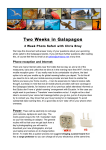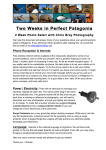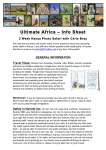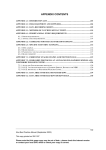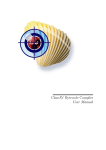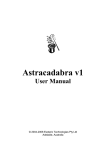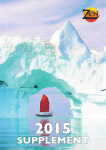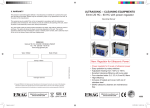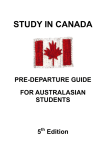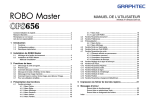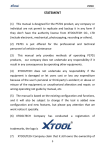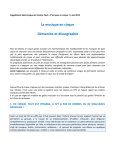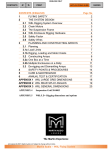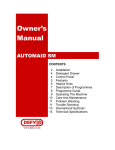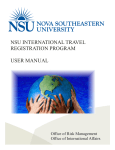Download Ultimate Alaska - Chris Bray Photography
Transcript
Chris Bray Photography’s Ultimate Alaska Information Document We hope you enjoy reading this information document - it’ll help you pack, help you get the most out of this safari tour and help answer any questions you may already have. IN THIS DOCUMENT ABOUT ALASKA TIME ZONE MOBILE PHONE RECEPTION INTERNET ELECTRICITY AND POWER CLIMATE MONEY AND CURRENCY SAFETY GETTING ORGANISED: TRAVEL ARRANGEMENTS JOIN THE FB GROUP ENTRY INTO THE USA FLIGHTS LUGGAGE RESTRICTIONS AIRPORT TRANSFER ARRANGEMENTS INSURANCE MEDICAL INFORMATION IN CASE OF EMERGENCY ITINERARY ARRANGEMENTS ITINERARY ACCOMODATION ARRANGEMENTS DAY TRIP POSSIBILITIES WHAT TO PACK BAGS CLOTHING OTHER CAMERA GEAR LENSES CAMERA BODY MEMORY CARDS AND FILE STORAGE LOOKING AFTER YOUR GEAR BORROWING OUR EPIC 600mm LENS BORROWING BEAN BAGS HIRE SOME GEAR OTHER POINTS OF NOTE GENERAL CODE OF CONDUCT WHY BOOK A SAFARI WITH CBP? CONTACT US ABOUT ALASKA For those who have never visited, it is nearly impossible to quantify the vastness of Alaska. Being the largest state of the Unites State and populated by less than 750,000 people (about half them crowded into the Anchorage metro area), much of Alaska is untouched wilderness. TIME ZONE The Alaskan Time Zone observes standard time by subtracting nine hours from Coordinated Universal Time (UTC−9). That puts it 19 hours behind AEST. MOBILE PHONE RECEPTION As far as mobile reception goes you will only really have service while in the metropolitan areas of Alaska, like Anchorage. It’s unlikely there will be mobile phone service while on either of the boats. If you really need to be contactable via phone the best option is to set your mobile up for global roaming before you depart. To do this, you’ll simply need to call your mobile service provider and ask them to enable global roaming before you leave your home country – it can be expensive to make & receive calls though! To avoid substantial data roaming fees, it’s a good idea to turn your phone’s ‘data’ or ‘data roaming’ off when overseas. It might also be a good idea to re-‐record your voicemail message before you go too, just so that if anyone does try to contact you, they’ll know that your busy having fun in Alaska and not to keep calling you! INTERNET There will be Wi-‐fi Internet connection when we stay at the Historic Anchorage Hotel on the first night and the last night of the safari. The Dream Catcher boat (which we spend 7 days on) offers satellite comms for internet access and has a satellite phone, but both are expensive. You can purchase 10 Mb of internet data for around $135 (ie suitable for email only and no large attachments). They also have $40 satelite phone cards that’ll last around 30min of calls. They sell these as pre-‐paid data uplink cards on board. ELECTRICITY AND POWER There will be electricity to recharge your cameras, laptops etc each day. The mains power plug is the ‘US / Canadian’ style so you’ll need an adaptor. The general routine will be that, once we get back from a day’s photographing, you’ll want to download your new photographs and put your camera/laptop on to charge before dinner. To make this process quicker we suggest you bring a power board that has a surge protector so you can charge all of your electronics at the same time. Surge Protectors are a very good idea when traveling overseas. While we’ve not had any bad experiences in Alaska, using a surge protector when charging things like a laptop will help prevent any electricity spikes damaging your electronics. CLIMATE We are travelling to Alaska in mid summer, where days are long (Anchorage has 17hrs of daylight in July)! The weather is really variable, and even though it’s summer, you can still expect some days of fog, mist, clouds and rain… as well as glorious sunshine of course. Cold days and nights could be around 5O C, warm days around 15O to 18O C and hot days above 20O C. The key to comfort in Alaska is wearing layers that can be peeled off as needed. See the ‘clothing section’ of this document. MONEY AND CURRENCY The currency in Alaska is the US dollar (USD). Most places will take a credit card and there will be several ATM’s. It’s best to carry some cash on you for purchases like food, drinks and trinkets. Don’t for get to let your bank know that you will be overseas for two weeks. If your bank is unaware that you’re in Alaska they might suspend your credit card the first time you try to use it, making it very hard to get any money out at all. SAFETY In general, crime is not a problem at all in Alaska so there is little to be concerned about. As with all places in the world though, when you’re using expensive equipment like cameras just keep an eye on them and always have them strapped around you. Don’t take chances. Most of the places we’ll be visiting on the boats will have have next to no other tourists or people, so it’ll be very safe. GETTING ORGANISED: TRAVEL ARRANGEMENTS JOIN THE FACEBOOK GROUP We have a facebook group is for those who’ve been on (or are about to go on) a Chris Bray Photography Safari. This is a space to e-‐meet fellow travellers, ask questions of veteran travellers and generally get excited (or reminisce) about the trip of a lifetime! You must be booked in to join (and post), but feel free to check it out and read what people have said. https://www.facebook.com/groups/284882211541277/ ENTRY INTO THE U.S.A Australian citizens are able to travel to the United States without a visa by using the Visa Waiver Program (VWP), with an approved ESTA (Electronic System for Travel Authorisation). International travellers who are seeking to travel to the United States under the Visa Waiver Program (VWP) are now subject to enhanced security requirements and will be required to pay an administrative fee. All eligible travellers who wish to travel to the U.S. under the Visa Waiver Program must apply for authorization and then pay the fee. Use the link below to work your way through the application process. http://canberra.usembassy.gov/nonimmigrant-‐visas.html FLIGHTS The price does NOT include flights from your hometown to Anchorage, Alaska, nor your return flight back home. We have our own travel agent (Jacqui Smith <[email protected]>) who is more than happy to help answer all your questions and help you find and book the best flights, travel insurance etc. She has been working with us for a few years now and knows the in’s and out’s of our safaris. Once you have booked your flights, please email us a copy of your flight itinerary. ([email protected]). The safari does include the domestic flights between Anchorage and Kodiak as well as a floatplane flight between Kodiak and Geographic Harbour. LUGGAGE RESTRICTIONS Due to the nature of the domestic and floatplane flights there will be strict luggage restrictions. Please visit the Alaska Airways website for more information on Carry-‐ on and Checked-‐in baggage. The same baggage restrictions will apply for the floatplane. Carry-‐On Baggage: You are allowed one carry-‐on bag which, including wheels and handles, can measure up to 10”H x 17”W x 24”L (25 x 43 x 61 cm), plus one personal item such as a purse, briefcase or laptop computer. Acceptance of carry-‐on baggage is subject to space and availability on the aircraft at the time you board. Items exceeding the free carry-‐on allowance will be charge $25 per piece and tagged for delivery to baggage claim at your destination. Checked Baggage: You are allowed one check-‐in bag that must weigh 50 Pounds (22.5kg) or less and have a maximum dimension of 62 linear inches (or 157 linear cm) [length + height + width] to avoid additional charges. AIRPORT TRANSFER ARRANGEMENTS The airport transfer from Anchorage Airport to the Historic Anchorage Hotel on the first day of the safari, and returning to the airport on last day of the safari are included. INSURANCE Chris Bray Photography will not be liable for any damage to your camera gear or equipment, nor your personal health or wellbeing. You MUST organise your own travellers insurance (with cancelation insurance) for all our safaris and email us a copy of your policy to [email protected] with your final safari payment. Not only will this cover you and your gear, but also if you needed to pull out at the last minute, you should be able to get a refund from the insurance company, which is great! Once again our travel agent Jacqui, <[email protected]> is very willing and able to help secure you the best deal here. In fact she can often organise a discount for our clients! MEDICAL INFORMATION Closer to departure we will email you a medical information form that we will ask you to fill in and email back to us. It’s not that we care what medication you take, but if you are involved in an accident and end up in hospital for some reason – we need this information on hand to give to the doctors. So please fill the medical form honestly and openly, with this in mind. To comply with US Coast Guard ship requirements we’ll also email you another document supplied to us by the “Dream Catcher”, it may seem like we are doubling up but you must also fill in this document. IN CASE OF EMERGENCY We’ll have a satellite phone at all times that’ll work just about everywhere and are both trained in remote, wilderness first aid. We will carry an extensive first aid kit, although you must bring any personal medication which you may likely need. ITINERARY ARRANGEMENTS ITINERARY INFO The exact order of the itinerary may be shuffled around and tweaked due to weather etc., but you can be rest assured that we'll be working flat-‐out to get you to all the best places, for the best photos possible. Fitness level and physical activity A moderate level of fitness is required. You need to be mobile enough to clamber in and out of boats/Zodiacs (or possibly on to rocks) and wander around for a morning or afternoon with your camera bag on your back. If you’re concerned, feel free to email us. Food and Drink While on-‐board our two ships all meals and drinks (including a responsible amount of alcohol) is included. All other meals, snacks & drinks are not included. Please read the day-‐to-‐day itinerary carefully so you know which meals are included on the safari. As a general guide an average dinner might cost between $20-‐$30US; lunch between $10-‐20US; soft drink $5US; beer and wine, $7-‐$10US. Generally speaking food in Alaska tends to be more expensive than the rest of the USA. Sea Sickness The majority of this Safari will be based on boats so if you know you get sea sick easily, then remember to pack some anti-‐sea-‐sickness tablets, ginger, pressure bands or whatever it is that you find works for you! (By the way, when I go sailing, I use ‘15mg Stugeron tablets’ which I buy online from Canada – seems to be the only stuff that works for me. Jess uses transdermscop (scopolamine 1.5) patches – the benefit of these being that you don’t lose the medication if you do become sick!). Don’t stress out, though, we’ll be cursing and anchoring in very protected and sheltered areas within Prince William Sound and Geographic Harbour. ACCOMODATION ARRANGEMENTS Accommodation arrangements vary for each location, however it is all twin-‐share. So if you're booking on your own then expect to share a room with someone else. If you're booking as a couple then we can organise a double bed rather than two singles -‐ just let us know. For solo travellers we can't guarantee that we'll always be able to have you sharing with someone of the same sex -‐ it depends on the gender split, but we do our best. You can request a single supplement (a room to yourself) -‐ just email us and we’ll let you know the extra costs. Keep in mind though that a) you're only usually in your rooms to sleep as we fill your waking hours with plenty to do, and b) the couple of times we have had clients get rooms for themselves, they end up regretting it when they see the amazing friendships that form between other roomies. WHAT TO PACK WHAT KIND OF BAGS DO I BRING? Considering we’ll be spending most of our time on boats the best kind of check-‐in bag you can bring is a duffle/soft bag or back pack (preferably one with wheels to make it easier to manage when transiting through airports) so you can empty, collapse and stow away when saying on board. Please don’t bring a suitcase or any kind of hard case as they are awkward to stash away on board. Remember to check the luggage restrictions (above). CLOTHING You will need some comfortable, lightweight ‘Safari clothes’ to allow for ease of mobility (to get down low for interesting shots, to climb in and out of boats etc). Pockets are useful for things like lens caps, lens cloths etc. Long-‐sleeves (and full-‐ length pants) will help keep the sun off and are a great idea. You’ll find that your main clothes will be a couple of lightweight, loose pairs of full-‐length safari pants and similarly loose, breathable tops and, depending on the weather, thermals & jackets. It would be ideal if these clothes were naturally earthy, pastel colours – we don’t want to frighten the animals! We recommend and wear “Craghoppers”. They make great outdoor tops and pants with inbuilt permanent mosquito repellent that are lightweight, durable, confortable and even fashionable in a variety of different colours. You can purchase Craghoppers directory from us with our embroidered ‘Chris Bray Photography Logo’ for cheaper then you’ll find in outdoor retail stores. Don’t forget to bring a warm fleece, a really warm jacket (like a down jacket), thermals, gloves, bennies, scarfs, woollen socks and wet weather gear like a good quality raincoat and rain pants too. You might also want to bring something smart-‐ casual to wear for dinner on some nights when you’re sick of living in your safari gear and have enough time to change. Just remember we’re here to see things, not be seen! =) Think long and hard about what gear to take, as you don’t want to be lugging too much stuff around! ‘Less is more’ is a great rule of thumb. And last but not least, don’t forget a hat! Make sure it’s a wide-‐brimmed hat – and ideally without too stiff a brim (and certainly not a peaked baseball cap) as these stiff brims get in the way when you try and hold your camera up to your face. A draw-‐ cord on your hat is not a bad idea, as it can get a bit windy on the boats! Washing Don’t worry you wont have to bring 14 shirts and 14 pairs of undies!!! There are facilities to do your washing on the ‘Dream Catcher’ boat that we spend 7 days on. OTHER SUGGESTIONS • • • A good quality raincoat and rain pants, we recommend and use Gore-‐Tex. Helly Hanson rain gear will be provided on the “Dream Catcher” ship – however not on the “Coastal Explorer” so it’s better that you invest in your own! Rain cover for your camera and long lens; you can pick one of these up on e-‐ bay for about $30 and they are well worth it! Shoes – Gumboots will be provided on board, we recommend bringing thick wool-‐hiking socks to wear with the boots for extra comfort. When on board tennis shoes or sandals are fine. A good pair of hiking boots might come in handy for longer walks. Head torch Sunscreen & mozzie repellent! Sunglasses (polarized will be best!) Lip moisturiser with Sunscreen i.e. Blistex Travel alarm clock (or Phone!) Personal medication & toiletries (Shampoo, toothpaste, etc.) • • • • • • Note: E ntry i nto t he A laska I slands p rohibits t he i mportation o f f resh f ruit, plants o r s eeds, s o k eep t his i n m ind w hen p acking. CAMERA GEAR We do not loan out our own camera equipment for this trip. We will bring a spare camera just incase but be prepared to be fully self-‐sufficient regarding your camera gear, tripods etc. If you’d prefer not to purchase gear, we offer very competitive camera and lens hire to our safari guests! See below. LENSES In an ideal world you’d want a good wide angle zoom lens for landscape shots, a standard-‐ish zoom lens (wide-‐ish to zoomed-‐ in-‐ish) for the ‘every day’ kind of shots, and a fairly serious telephoto lens (probably also a zoom) for all the wildlife shots. However, you DO NOT NEED TO GO AND SPEND A FORTUNE ON LENSES to get amazing photos! We can get quite close to a lot of the animals so even something like a twin lens kit (wide-‐to-‐normal, and normal-‐ to-‐telephoto) will cover your bases. However, some animals are small (especially birds) and some are harder to get close to, so a good long telephoto lens up to say 300mm or ideally even 400mm will sometimes make the difference between a good photo and an amazing photo. So if you are thinking of buying one special lens for this trip, make it a telephoto zoom lens, and, if you’re tossing up between spending some $’s upgrading the body of your camera or buying a telephoto lens instead – buy the telephoto lens!!! I have written down a few suggested lenses below, the specs and the RRP. Please note the RRP is from Digital Camera Warehouse and prices do vary between different stores, so shop around. Also keep in mind that there is nothing wrong with getting a good second-‐hand lens from e-‐bay (assuming its in good condition!). If you have other creative lenses like macro lenses or fisheye lenses, bring them along as well, it’s always fun to have a play with different angles. Lens overview – (for Canon Cameras): Wide-‐angle Lenses Canon EF-‐S 10-‐22mm 1:3.5-‐4.5, RRP $939 (Great very wide lens for ‘sub-‐frame’ cameras – that’s basically any camera except the 1D series or the 5D mk II!) Canon 17-‐40mm 1:4 L USM, RRP $949. Canon 16-‐35mm 1:2.8 L USM, RRP $1,929 (My favourite) Standard Lenses You wont be using a standard lens that much, so to be honest, whatever came with your camera will probably be fine. But if you are in the market for an upgrade you really can’t go past the Canon 24-‐105mm USM IS L 1:4 – My favourite all-‐rounder / workhorse lens. Telephoto Lenses Most of what we will be shooting will benefit from a good long telephoto lens. The ideal focal length you would want to totally maximise your experience in Alaska is 400mm. However that’s not to say that you wont get awesome shots on most subjects even with a 300mm if that’s all you have. I’d hesitate against using anything shorter than 300mm, though (as your longest lens). The ideal wildlife lens that we recommend is: Canon 100-‐400mm EF 1:4.5-‐5.6 IS USM L, RRP (DCW) $1,999 You will be able to pick one of these beauties up for about $1,400 on e-‐bay at the moment, but they might not come with an Australian warranty. But this lens will give you superbly sharp and zoomed-‐in, big full-‐frame shots, and its image stabilisation is great. Remember the longer the lens, the more important it is to have image stabilisation. The other seriously long telephoto lens (which is a little cheaper than Canon’s 100-‐ 400mm) is the Sigma 150-‐500mm 1:5-‐6.3 DG OS HSM, RRP $1,200. Now, this lens is great for those who can’t afford the Canon telephoto lens -‐ it goes to a whopping 500mm, which is fantastic, but unfortunately it’s not as fast (not as small an f/#), the ‘OS’ (optical stabilization) does not work as well as on the Canon lens, and the images don’t tend to be quite as sharp. But yet, you get what you pay for, and this is certainly still a superb lens and great value for money J Tele-‐extenders Tele-‐extenders are affordable little ‘spacer lenses’ that go between your camera and your telephoto lens to make the lens longer – to ‘extend’ the focal length of your longest lens. You can get various sizes, but commonly you can get a 1.4x extender, or a 2x extender that will multiply the focal length of the attached lens by 1.4x and 2x respectively. So a 2x tele extender on a 100-‐400mm lens turns it into a 200-‐800mm epic lens! However, there is a catch. 1. You may loose a little image clarity, 2. You won’t be able to scroll down to such small f/#’s anymore as tele extenders ‘reduce the maximum effective aperture’ of the lens, and, 3. You may LOSE THE ABILITY TO AUTOFOCUS your lens! You've got to be very careful with tele-‐extenders and Auto-‐Focus (AF). My understanding is: For AF to work, the 'max effective aperture' of the lens & extender combined must be at least f/5.6 (or a slightly more tolerant f/8 for pro 1D series cameras). The 2x tele-‐extender reduces the max effective aperture by '2 stops' (F# scale increasing by 1 stop at a time goes like this: f/1.4, f/2, f/2.8, f/4, f/5.6, f/8). So for the 2x tele to work on a normal camera, the lens you’re attaching it to would need to be a f/2.8 lens or faster (ie, seriously fast & expensive), but the 1.4x tele extender only reduces the f-‐stop by 1 stop, so you could get AF with a lens f/4 or faster (as it will ‘become’ an f/5.6 or faster). SO – I usually recommend to people that, if they want a tele-‐extender, go for the 1.4x tele, else many of your lenses won't AF anymore (unless you have a super expensive fast lens), which can be a big pain. You DON’T NEED a tele-‐extender for the Alaska trip, but it is a good tool to pull out to give you that little bit more reach sometimes if you have one. Keep in mind that you can always borrow camera equipment from hire places in Australia – so if you’re not interested in purchasing your own, perhaps look into how much it would cost to hire. Remember though that if your longest telephoto lens is only an f/5.6 lens, then even if you just use a 1.4x tele, you still wont be able to AF (not that manual focus is impossible to use, it just slows you down a lot!) CAMERA BODY Again, it’s more important to have a good telephoto lens than a brand new camera body, however if you are looking to upgrade your camera body, here are some simple guides, as of October 2013. You can always email us at [email protected] and we can help you out with some current advice. Remember that we don’t make a cut out of what you end up purchasing, or have any stock we’re tying to sell-‐off, unlike the guys at some camera stores. If you don’t own a camera yet, and are only looking at an entry level camera, then the Canon 700D is great (and records HD video too, as do the others we will now look at!). You can also hire one of our 600D’s if you’d like, just let us know in advance. (See below). Looking at the mid-‐range ‘enthusiast’ level cameras which the majority of safari travellers will be using, currently I’d say the best ones to look at (in increasing order of price and awesomeness) are the Canon EOS 70D, then the 7D. Up from there you get into full-‐frame cameras including the 6D and the 5D mk III, both amazing cameras – but realise that with a full-‐frame camera your lenses don’t seem as zoomed in. ‘Sub frame’ cameras make your lenses seem about 1.6x more zoomed in, which can be great for wildlife, so don’t fall for the trap of thinking that a full-‐frame is ALWAYS going to be better for you. Think long and hard between a 5D mk II and a 7D – I’d go the 7D for various reasons (the fact it’s not full-‐frame is actually a good thing for wildlife shooting, as we just said), the 7D also has an in built flash, can take up to 8 pics/sec in burst mode (for when the sea-‐eagle swoops and snatches up the fish from the lake!) compared to 3.9 pics/sec of the 5D mk II etc. The 5D mk III, though, blows the 7D out of the water. After the 7D, 6D, 5D’s, well, if you want to step into the professional range of cameras, then you’re looking at the Canon 1D mk IV or a 1D X. If you are looking at up-‐grading your canon body and are feeling a bit overwhelmed with choice, feel free to shoot us an email ([email protected])! Remember that we don’t make a cut out of what you end up purchasing, or have stock we’re tying to sell-‐off, unlike the guys at some camera stores J. SHOULD I BRING TWO CAMERAS? If you happen to have two cameras (don’t worry if you don’t, it’s kind of a bit excessive!), some people find it great to bring them both, with a long lens attached to one, and a wide lens attached to the other – this means that you don’t have to change lenses so much, it’s faster, and also provides redundancy/backup should your camera fail. If you have a little compact ‘point-‐and-‐shoot’ camera for your pocket, that might come in handy too! Again, if you only have one camera that’s totally fine! MEMORY CARDS AND FILE STORAGE While you should certainly be practicing restraint and only taking photos that are worth taking, you’ll still need LOTS of memory cards and it might also be a great idea to bring some kind of data backup system. A laptop with an external hard drive is good, as with a laptop you have the big advantage that you can look at your photos each night, see how they turned out, learn from them, tweak them, put them online etc, but has the disadvantage of being heavy and delicate to bring. Plus it’s one more thing to keep charged! If at all possible though, you will really appreciate having a small laptop with you – a MacBook Air would be ideal, and more useful than an iPad! Another option is using a ‘portable media storage device’ like a ‘Wolverine PicPac II – 320 GB Digital Camera Backup System’ that is basically a hard drive and a card-‐ reader built into one, that just takes the photos from your card right onto it’s inbuilt hard drive, without the need for a laptop. These are good in theory, however you can’t see your photos very well (or not at all on some of them) and you will want to learn how they work before you leave! To be honest, we do not recommend these devices as they are confusing and we have had several of them fail on safaris. Some people simply opt to bring enough spare memory cards that they don’t even need to copy them onto anything – you’ll just have to get good (and ruthless) about deleting your less-‐good photos every evening, just by peering at them on the back of your camera – which is hard! As a ballpark figure, you will need anywhere from 30GB to 50 GB of storage space for the two weeks, assuming you’re shooting in highest quality JPEG mode. If you’re shooting in RAW mode, or additionally shooting large amounts of HD video, then you might need more storage, perhaps up to a whopping 200GB if you’re totally crazy. To avoid the risk of losing your images if a memory card fails, you should always try to keep two copies of your photographs. For example I use a laptop and two identical external hard drives and each evening I download my photos onto the first one drive, then copy them additionally to the second one before deleting/formatting the memory card -‐ just in case! OTHER • Camera backpack /daypack, preferably one that has an inbuilt rain cover – something big enough to carry all your camera gear in and a rain jacket etc. • • • • • • Tripod – This is a MUST! When we photograph the bears at Geographic Harbour we’ll be sitting on little camping stools (supplied by the ship) and it’s much more comfortable to have your camera and long lens attached to a tripod than hand hold your camera for hours. Trust us, your arms will get very sore and you’ll miss fantastic photos if you don’t bring a tripod that can support your telephoto lens. Happy snap camera (if you don’t have one and are looking at purchasing one – get an underwater one like a Canon D20, or a GoPro camera for great underwater filming!!! If you are bringing a GoPro with you, and it is an older model (either Hero 1 or Hero 2) it is seriously worth investing in their specific underwater/dive housing – it has a flat glass port rather than curved, which results in much sharper images underwater.) Hero3’s come with this flat port as standard. Snap lock bags (for rainproofing camera gear) Spare camera batteries -‐ Even though you will be able to re-‐charge your battery each night, it’s not a bad idea to carry a spare, in case there is a blackout and you can’t recharge. Your camera’s user manual – just in case even Jess and I really can’t work something out on your camera! Camera sensor cleaning equipment such as an air-‐blower (optional – at your own risk – I can help and will have one of my own) LOOKING AFTER YOUR GEAR The biggest issues with you camera gear in Alaska will be sea spray and rain. It’s not a bad idea to get a lens coat cover to protect your lens, as mentioned above. You’ll need a water proof cover for your camera and lens. Your camera bag should have an inbuilt rain cover. A great example is the Lowepro Flipside series (that you can now purchase through us!) LENS AND CAMERA HIRE We have a set of camera bodies and various lenses, which we can hire out to our safari guests at very competitive prices. Hire is subject to availability. Please email [email protected] to book. Items available for hire for our two week Alaska Safaris: • Canon 600D camera body-‐only, $300 • Canon 100-‐400mm f/4.5-‐5.6L IS USM lens, $400 • Canon EF 70-‐300mm f/4-‐5.6 IS USM lens, $250 • Canon EF 100mm f/2.8 Macro USM, $150 • Canon EF-‐S 10-‐22mm f3.5-‐4.5 USM (wide angle), $150 • Canon EF 17-‐40mm f4L USM (wide angle), $200 OTHER POINTS OF NOTE GENERAL CODE OF CONDUCT The aim of the safari is to have a really enjoyable time learning and practicing photography with like-‐minded people, shooting some of the most amazing subjects in the world and lapping up a few of life’s little luxuries. An aim of CBP is also to appreciate the natural world in a sustainable manner, so future generations can continue to experience its beauty. Please help us ensure everyone has a great time by cooperating with us in the following. • Look after the wildlife -‐ Please don't handle, feed or harass the wildlife. When viewing the wildlife please keep noise down to a minimum. Don't surround, chase or approach the animals too closely. Excitedly jumping around and shouting at how amazing it is will only cause the animals to disappear, much to the annoyance of your fellow travellers! We are here to photograph the animals, not stress them out • Look after the environment -‐ "Take only photographs, leave only footprints." Where possible please stay on the designated footpaths and walkways. Please recycle and dispose of litter in the appropriate bins. • Look after your fellow photographers -‐ be considerate of the other group members at all times. WHY BOOK A SAFARI WITH CHRIS BRAY PHOTOGRAPHY? If you’ve been on safari with us before, you already know why, and our ridiculous repeat guest rate speaks for itself – we’ve had some people book on every single safari we offer! We’ve had entire safaris sell-‐out solely with repeat customers. We love you guys, and we get the feeling it’s mutual =) But if you’re a newcomer, then lets be objective here: • Now running 10+ photo safaris in Australia & overseas every year, Chris Bray Photography is one of the biggest photo safari companies in Australia. Thanks to the care we put into our trips, we are still growing faster than ever, opening up new destinations each year • This is important – on many other photo safari trips guests basically ‘Join this amazing photographer as he/she travels to and photographs this and that”, and • • • that is exactly what happens – the leading photographer gets themselves in the best position and shoots amazing images, tossing the odd scrap of advice to his/her clients who are basically left to snap what shots they can from behind. That is not how we operate – we are there solely to help YOU get the best shots, help you with the settings, the location, the composition etc – we’ll only ever start taking our own photos if everyone in the group is happily photographing, and then you’ll notice that we’re careful to keep out of your way. And if we find a great angle or location, we’ll come and grab you and take you there! It’s a very different philosophy, and one that we pride ourselves on. Unlike many other photo safari operators, Chris Bray Photography is actually a fully registered and licensed Australian Travel Agent. Not only does this mean that we are actually operating legally (it is illegal to run a business grossing more than about $50k/yr selling clients the right to either travel, be transported or be accommodated anywhere without being a registered travel agent), but it also gives you peace of mind when booking with us, as you know that our company has managed to jump through all the very strict hoops, audits and checks that the licensing process demands. These checks ensure that we run our business correctly and have sufficient capital and safety structures in place (for example rather than us spending your money in advance to book and run the safari – which would mean if either party had to pull-‐out, we wouldn’t have your money anymore to give back to you -‐ we hold your money in a separate trust account until after the safari is finished enabling us to issue refunds if required). We even contribute to the Travel Compensation Fund, to help out travellers who have been caught out by dodgy operators! Of course we’re also a completely Aussie owned and operated company! Again, unlike many others, we are running our safaris by the books. We have, for example, already purchased the required photography permits to shoot in the areas of KI we go, and have got the required tour operator accreditation from the South Australian Parks & Wildlife service. This means we run things properly, respect the environment, and are proving funds back into the system to sustain the natural beauty that we all come to enjoy. Being Lowepro’s ambassador, and an Australian Geographic photographer, coming on a photo safari with Chris Bray is a chance to be taught by one of the best. Having taught photography courses and run safaris for 4 years, Chris and Jess are familiar with, and constantly up-‐to-‐date with, all brands and models of cameras. Being young, enthusiastic and friendly makes for a wonderful team and group friendship. Having photographed from as far south as Antarctica, up through the sweltering tropics of PNG and Borneo, right up to the arctic in the north on world first expeditions and other harsh, high-‐stress environments, Chris has developed a very easy-‐going, practical approach to photography that helps encourage and reassure people that photography really isn’t about graphs, calculations and concerns. It’s really very simple. We teach the basic important stuff in our 1 Day Photography Courses and after that, it’s just practice to improve… which is exactly what we do on our safaris! PAYMENT PLAN • • • A non-‐refundable $1,000 deposit is required at time of booking to secure your spot. The rest of the payments are split over various payment deadlines, most of which become non-‐refundable if you pull out after a given payment date, except for the last sizeable chunk. If you pull out after this date, you will receive this final payment back (unless you pull out inside 45 days prior to departure, in which case it is not refundable -‐ like most tour operators). This is one of the reasons we require you to have travel insurance so you wouldn't be left out of pocket for such unexpected late cancellations. This safari is subject to minimum numbers, and we reserve the right to cancel the trip if minimum numbers are not met. In this unlikely event, we will of course return all payments to you CONTACT US Please, if you have any questions that are not yet covered in this document, please just ask us at [email protected] and we’ll let you know, and then add the info to this document for others! Thanks! Cheerio, The CBP Team www.ChrisBray.net [email protected] Mobile: +61-‐(0)402-‐839-‐929






















